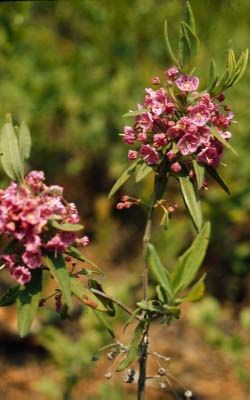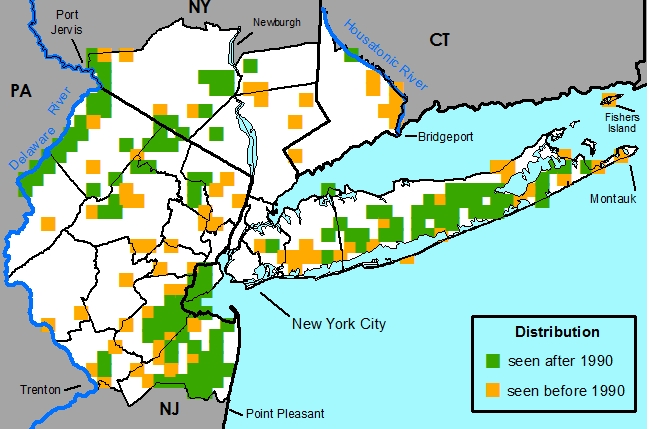Kalmia angustifolia L. - Sheep Laurel

Sheep Laurel
Photo © Peter Nelson, 1971, taken in the New Jersey pine barrens.
Common Names
Sheep LaurelField Identification
A shrub with whorls of elliptic leaves and pink to red bell-shaped flowers.Common names
Dwarf Laurel
Lambkill
Narrow-Leaved Kalmia
Pig Laurel
Sheepkill
Sheep Laurel
Wicky
Poisonous properties
Disclaimer: The information provided here is for reference and historical use. If you believe you have been poisoned, please contact the Poison Control Office near you (look for the number in the front of the phone book).
(Hardin & Arena, 1974) (Jaynes, 1975) (Lampe & McCann, 1985) (Lewis & ElvinLewis, 1977)
Contains grayanotoxins (andromedotoxins), which are toxic diterpenes. Symptoms include transient burning in the mouth after ingestion. After several hours, increased salivation, emesis, diarrhea, and a prickling sensation of the skin. Other symptoms include headache, muscular weakness, and dimness of vision. Bradycardia is followed by severe hypotension. Coma may develop, and convulsions are the terminal event. Causing slow pulse, lowering of blood pressure, lack of coordination, convulsions, progressive paralysis, and death. Arbutin, a glycoside of hydroquinone, is also present and indicated in the poisoning.
Nomenclature
*Kalmia angustifolia L., Sp. Pl. 1: 391. 1753. *Chamaedaphne angustifolia (L.) Kuntze, Revis. Gen. Pl. 2: 388. 1891. TYPE: Location and collector unknown (Lectotype: LINN 560.2, specimen on right; photo: IDC 177, f. 315. r. 2, c. 6), selected by (Ebinger, 1974), see also (Southall & Hardin, 1974).*Kalmia angustifolia var. rubra Aiton, Hort. Kew. 2: 64. 1789. *Kalmia latifolia var. rubra (Aiton) Lodd., Bot. Cab. 6: t. 502. 1821. *Kalmia rubra (Aiton) Bosse, Vollst. Handb. Bl.-Gärtn., ed. 2, 2: 347.1841. *Kalmia angustifolia f. rubra (Aiton) Voss, Vilm. Blumengärt., ed. 3, 1: 591. 1894, pro syn., nom. inval. (Art. 34.1c). TYPE: Location and collector unknown (Holotype: BM?).
*Kalmia angustifolia var. carneaAiton, Hort. Kew. 2: 64. 1789. TYPE: Location and collector unknown (Holotype: BM?).
*Kalmia angustifolia var. oleifolia Pers., Syn. Pl. 1: 477. 1805. *Kalmia oleifolia (Pers.) Bosse, Vollst. Handb. Bl.-Gärtn., ed. 2, 2: 347. 1841 (pro syn.). TYPE: Type not designated, several elements.
*Kalmia angustifolia var. ovata Pursh, Fl. Amer. Sept. 1: 296. 1814. *Kalmia angustifolia f. ovata (Pursh) Beissn. et al., Handb. Landholzben. 386. 1903, nom. inval. (Art. 32.1c). TYPE: United States. New Jersey: mountains. Collector unknown (Holotype: ?). [leaves broad, subovate]
*Kalmia angustifolia var. pumila J. Forbes, Hort. Woburn. 93. 1833. *Kalmia pumila (J. Forbes) Bosse, Vollst. Handb. Bl.-Gärtn., ed. 2, 2: 347. 1841, nom. inval. (Art. 34.1c). *Kalmia angustifolia f. pumila (J. Forbes) Voss, Vilm. Blumengärt., ed. 3, 1: 591. 1894. TYPE: Location unknown, 1736, collector unknown (Holotype: K?). [dwarf]
*Kalmia angustifolia var. rosea J. Forbes, Hort. Woburn. 93. 1833. *Kalmia angustifolia f. rosea (J. Forbes) Beissn. et al., Handb. Landholzben. 386. 1903, nom. inval. (Art. 32.1c). TYPE: Location unknown, 1736, collector unknown (Holotype: K?). [rose-colored]
*Kalmia angustifolia var. variegata J. Forbes, Hort. Woburn. 93. 1833. TYPE: Location unknown, 1736, collector unknown (Holotype: K?). [variegated leaves]
*Kalmia ferruginea Raf., Autik. Bot. 86. 1840. TYPE: Type not cited [placed here by (Ebinger, 1974) but under Kalmia latifolia by (Southall & Hardin, 1974)].
*Kalmia elliptica Raf., Autik. Bot. 87. 1840, nom. inval. (Art. 34.1c). TYPE: Type not cited.
*Kalmia angustifolia var. minima Bosse, Vollst. Handb. Bl.-Gärtn., ed. 2, 2: 347. 1841. TYPE: Type not cited.
*Kalmia angustifolia var. nana Bosse, Vollst. Handb. Bl.-Gärtn., ed. 2, 2: 347. 1841. *Kalmia angustifolia f. nana (Bosse) Voss, Vilm. Blumengärt., ed. 3, 1: 591. 1894, pro syn., nom. inval. (Art. 34.1c). TYPE: Type not cited.
*Kalmia pumila rubra Bosse, Vollst. Handb. Bl.-Gärtn., ed. 2, 2: 347. 1841 (pro syn.). TYPE: Type not cited.
*Kalmia pumila serotina Bosse, Vollst. Handb. Bl.-Gärtn., ed. 2, 2: 347. 1841, nom. inval. (Art. 34.1c). *Kalmia serotina (Bosse) Bosse, Vollst. Handb. Bl.-Gärtn., ed. 2, 2: 347. 1841, nom. inval. (Art. 34.1c). TYPE: Type not cited.
¤Kalmia angustifolia var. hirsuta Jäger, Ziergeholze 278. 1865. *Kalmia angustifolia f. hirsuta (Jäger) Voss, Vilm. Blumengärt., ed. 3, 1: 591. 1894. TYPE: Unknown.
*Kalmia media Kalmia Koch., Dendrologie 2(1): 153. 1872, nom. inval. (Art. 34.1c). *Kalmia angustifolia f. media (K. Koch) Beissn. et al., Handb. Landholzben. 386. 1903, nom. inval. (Art. 32.1c). TYPE: Type not cited.
*Kalmia intermedia glauca var. intermedia Lange, Index Seminum in horto hauniensi a 1873. Nomina emendata. 3. 1873. *Kalmia glauca var. intermedia (Lange) Lange, Index Seminum in horto hauniensi a 1873. Nomina emendata. 3. 1873. TYPE: "Hort Paris", Denmark. Copenhagen Botanical Garden, 16 Jun 1873, collector unknown (Holotype: C) according to (Ebinger, 1974). [leaves glabrous, elliptic]
*Kalmia angustifolia var. lucida Lavalée, Inum. Arbres. 159. 1877, nom. inval. (Art. 32.1c). *Kalmia angustifolia f. lucida Beissn. et al., Handb. Landholzben. 386. 1903, nom. inval. (Art. 32.1c). TYPE: Type not cited.
*Kalmia angustifolia f. procumbens Beissn. et al., Handb. Landholzben. 386. 1903, nom. inval. (Art. 32.1c). TYPE: Type not cited.
*Kalmia angustifolia f. candida Fern., Rhodora 15: 151. 1913. *Kalmia angustifolia var. candida (Fern.) Rehder in Bailey, Stand. Cycl. Hort. 3: 1734. 1915. TYPE: Type not designated, two elements. [white-flowered]
Description
HABIT perennial, evergreen, chamaephyte, shrubs, autotrophic, monoclinous, with adventitious roots and with fibrous roots, 0.2-1 m tall, not modified or with rhizomes.STEMS erect, round, not winged, "regular". Prickles absent. Bark striate, not exfoliating, gray. Branches ascending, dark violet-red or dark gray, round, not winged, 2-3 mm in diam. Twigs yellowish orange or orange-yellow, not odoriferous, round, 1-2 mm in diam., smooth, hairs short and unbranched or long and unbranched, erect and spreading, unicellular and multicellular, uniseriate and multiseriate, white and orange-yellow, moderately dense or dense, throughout, glabrescent, glands present, glands at apex of hairs, dark orange-red. Pith present, light yellowish orange, round, continuous, nodal diaphragm absent. Thorns absent. Aerial roots absent. Sap translucent. Resin absent.
LEAVES whorled, 3 per node, crowded toward stem apex, divergent from stem, simple. Stipules absent. Leaves petiolate, petiole "typical", 0.3-0.7 cm long, hairs short and unbranched or hairs long and unbranched, erect and spreading, unicellular and multicellular, uniseriate and multiseriate, dense, throughout, not glabrescent, glands present, glands at apex of hairs. Leaf: abaxial surface light greenish yellow, adaxial surface greenish yellow, blades narrowly elliptic or elliptic, plane, symmetric, 2-5.9 cm long, 0.5-2.8 cm wide, coriaceous, base cuneate or obtuse, margin entire, apex acute or obtuse, abaxial surface glabrous, without glands, adaxial surface hairs short and unbranched, erect, unicellular, uniseriate, white, moderately dense, throughout, glabrescent, without glands. Eucamptodromous venation, veins 8-9. Leaf lobes absent. Spines absent. Tendrils absent.
INFLORESCENCES monomorphic, regular or, if dimorphic, female inflorescence simple, raceme, axillary, racemes appear verticillate. Peduncle present, 0.2-0.3 cm long. Rachis present, 0.4-0.8 cm long, with bracts. Bracts sessile, blades: abaxial surface green or yellowish orange, adaxial surface green or yellowish orange, ovate, curved or plane, 1-1.7 mm long, 0.8-1 mm wide, base truncate, margin ciliate, apex acute, abaxial surface hairs short and unbranched or hairs long and unbranched, abaxial hairs erect, unicellular and multicellular, uniseriate and multiseriate, white, dense, throughout, not glabrescent, glands present, glands at apex of hairs, dark orange-red, adaxial surface glabrous, without glands. Pedicel 8-11 mm long, hairs short and unbranched or hairs long and unbranched, hairs erect, unicellular and multicellular, uniseriate and multiseriate, white, dense, throughout, not glabrescent, glands present, glands at apex of hairs, dark orange-red. Bracteoles 2, sessile, at base of pedicel, not connate, bracteoles: abaxial surface green or yellowish orange, bracteole: adaxial surface green or yellowish orange, narrowly elliptic or lanceolate or elliptic or ovate, curved, 1-1.5 mm long, 0.5-0.6 mm wide, base truncate, margin ciliate, apex acute. Cupules absent.
FLOWERS serotinous, formed on short shoots, monomorphic, with sepals and petals readily distinguishable from one another, bisexual. Perfect or female flowers red, 5- merous, 0.5 mm long, 1.1 mm wide, 6-7 flowers per inflorescence, perianth of two whorls. Calyx present, actinomorphic, crateriform, of fused sepals, persistent, abaxial and adaxial surfaces the same color, light yellowish green or violet-red (with age), 1.7-2.5 mm long, 2.2-3 mm wide, tube 0.4-0.5 mm long, calyx limb 1.7-1.8 mm long, 2.2-2.6 mm wide. Sepals or sepal lobes 5, lanceolate or ovate, 1.9-2.1 mm long, 0.9-1.2 mm wide, base truncate, margin ciliate (with and without glands), apex acuminate, abaxial surface hairs short and unbranched and hairs long and unbranched, erect, unicellular and multicellular, uniseriate and multiseriate, white, dense, throughout, not glabrescent, glands present, glands at apex of hairs, dark orange-red, adaxial surface hairs long and unbranched, without glands. Epicalyx absent. Corolla present, actinomorphic, acetabuliform, of fused petals, deciduous, abaxial and adaxial surfaces the same color, 4.5-5 mm long, 8-11 mm wide. Petals or petal lobes 5, "normal", shallowly deltate, 0.5 mm long, 0.7 mm wide, base truncate, margin entire, apex acute, abaxial surface glabrous, without glands, adaxial surface glabrous, without glands. Gynoecium syncarpous. Carpels 5. Stigmas 1, lobed, flat, 5-lobed. Styles not persistent, 1, 4.1-4.3 mm long. Ovary superior, nectiferous disk present. Locules 5. Placentation axile. Androecium obdiplostemonous. Stamens 10, 2.5 mm long. In pockets on the corolla. Anthers oblong, opening by pores in terminal tubes, bithecal, red, glabrous. Filaments free, straight, red, hairs short and unbranched, erect, unicellular, uniseriate. Staminodes absent.
FRUITS septicidal capsule, reddish orange, depressed-globose, 2.1-2.5 mm long, 2.7-3.2 mm wide, hairs short and unbranched and hairs long and unbranched, erect, unicellular or multicellular, uniseriate or multiseriate, white, moderately dense, throughout, glabrescent, glands present, glands at apex of hairs, dark orange-red.
SEEDS many, light orange-yellow, oblong, 0.6-0.8 mm long, 0.2 mm wide, wingless, not tailed, lineate.
Habitat
Wet areas (bogs, shrub fens, moist ground, wet border, wet pasture, sandy bog, sphagnous meadow, marl pits) and dry areas (pine barrens, sand hills, stony soil, edge of oak-heath woods, reverted field, pine woods, sandy thicket, sandy woods, pine woods, mixed woodland, oak-hickory). Wet sphagnum peat, moist and dry upland peat and dry sand, pH 4.5-6.
Rarity Status
Heritage global rank -- G5Connecticut -- not listed
New Jersey -- not listed
New York -- not listed
Species Biology
FloweringMay [week 2] - July [week 1] (Aug [week 3]).
Pollination
(Heinrich, 1976) (Jaynes, 1968) (Jaynes, 1988) (Lovell & Lovell, 1934)Melittophily -- Pollinated by andrenid bees, particularly Andrena vicina Sm., Bombus ternarius Say, B. terricola Kby., and B. vagans Sm. The flowers are rarely visited by Andrena imitatrix Cr.
Autogamy -- Pollen can be carried by wind a foot or more, but it is only weakly self-compatible.
Fruiting
June [week 3] - Sep [week 4] (May [week 4]).
Dispersal
Anemochory -- Probably dispersed by wind.
Germination
(Jaynes, 1982) (Jaynes, 1988)Germinable -- No dormancy or only a hint in southern populations; temperature for initial growth is 70°-75°F.
Light required.